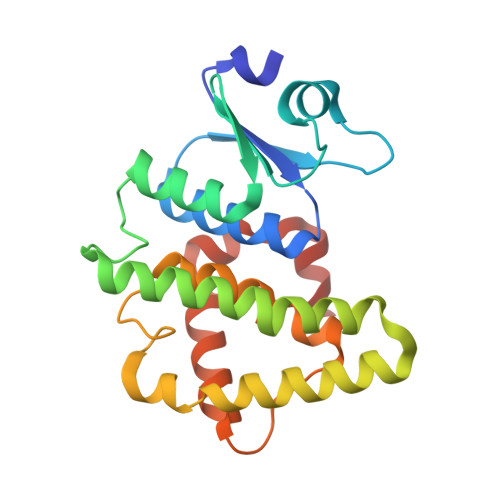Structural basis for the function of stringent starvation protein A as a transcription factor
Hansen, A.-M., Gu, Y., Li, M., Andrykovitch, M., Waugh, D.S., Jin, D.J., Ji, X.(2005) J Biol Chem 280: 17380-17391
- PubMed: 15735307
- DOI: https://doi.org/10.1074/jbc.M501444200
- Primary Citation of Related Structures:
1YY7 - PubMed Abstract:
Stringent starvation protein A (SspA) of Escherichia coli is an RNA polymerase-associated transcriptional activator for the lytic development of phage P1 and is essential for stationary phase-induced acid tolerance of E. coli. We report the crystal structure of Yersinia pestis SspA, which is 83% identical to E. coli SspA in amino acid sequence and is functionally complementary in supporting the lytic growth of phage P1 and acid resistance of an E. coli sspA mutant. The structure reveals that SspA assumes the characteristic fold of glutathione S-transferase (GST). However, SspA lacks GST activity and does not bind glutathione. Three regions of SspA are flexible, the N and C termini and the alpha2-helix. The structure also reveals a conserved surface-exposed pocket composed of residues from a loop between helices alpha3 and alpha4. The functional roles of these structural features were investigated by assessing the ability of deletion and site-directed mutants to confer acid resistance of E. coli and to activate transcription from a phage P1 late promoter, thereby supporting the lytic growth of phage P1. The results indicate that the flexible regions are not critical for SspA function, whereas the surface pocket is important for both transcriptional activation of the phage P1 late promoter and acid resistance of E. coli. The size, shape, and property of the pocket suggest that it mediates protein-protein interactions. SspA orthologs from Y. pestis, Vibrio cholerae, and Pseudomonas aeruginosa are all functional in acid resistance of E. coli, whereas only Y. pestis SspA supports phage P1 growth.
Organizational Affiliation:
Transcription Control Section, Gene Regulation and Chromosome Biology Laboratory, NCI-Frederick, National Institutes of Health, Frederick, Maryland 21702, USA.















